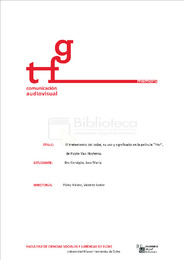Por favor, use este identificador para citar o enlazar este ítem:
https://hdl.handle.net/11000/6386El tratamiento del color, su uso y significado en la película "Her" de Hoyte Van Hoytema
| Título : El tratamiento del color, su uso y significado en la película "Her" de Hoyte Van Hoytema |
| Autor : Bru Cervigón, Jara María |
| Tutor: Pérez Valero, Vicente Javier |
| Editor : Universidad Miguel Hernández de Elche |
| Departamento: Departamentos de la UMH::Ciencias Sociales y Humanas |
| Fecha de publicación: 2018-07-10 |
| URI : http://hdl.handle.net/11000/6386 |
| Resumen : El presente trabajo tiene como objetivo principal el análisis del tratamiento del color utilizado en la película Her, del director de fotografía Hoyte Van Hoytema. Se pretende averiguar el significado de cada uno de ellos en su contexto, por lo que se analizará el uso del colorido en la producción de forma expresiva, narrativa y estética, acompañado de una recopilación de teorías del color de autores de diferentes ámbitos que distinguen los tonos según el significado (dentro de la sociedad y cultura occidental), que se le han ido otorgando a lo largo de la historia. ‘’El trasfondo psicológico e histórico permite explicar qué efectos de los colores están sujetos a una cierta regularidad’’ (Heller, 2004 :19). Para la realización de este proyecto se realizará un análisis exhaustivo del film Her como material base. Este proyecto puede ayudar a la investigación de los colores en otras producciones. La película será dividida siguiendo las fases por las que Theodore, el protagonista, transita a lo largo de la historia. Dependiendo de cómo él se encuentra y de lo que le acontece, los colores cambian y se modifican con ellos su significado. Así pues, es importante el estado de ánimo de Theodore para la historia y para el empleo del color. Her es una producción audiovisual en la cual el color tiene mucha importancia, pues acompaña la narración y estética de la historia. Asimismo, es cambiante, por lo que dependiendo de la escena y de lo que sucede, la tonalidad puede aportar un significado u otro completamente distinto. Los resultados más notorios en cuanto al uso del matiz en la película son las tonalidades pasteles, que predominan a lo largo de ésta, y en ellas se encuentran mayoritariamente tonos cálidos. Los colores fríos aparecen en contadas ocasiones, por lo que son más patentes al ser escasos. El tinte más utilizado de la película es el rojo y el anaranjado. Mientras que el verde es el que menos se manifiesta. Las tonalidades cálidas significan cercanía, por lo que el director de fotografía las utiliza para que el espectador se ponga en la piel del protagonista y pueda sumergirse mejor en el relato. The main objective of the present work is the analysis of the color treatment used in the film Her, by cinematographer Hoyte Van Hoytema. The aim is to find out the meaning of each of them in their context, so the use of color in production will be analyzed in an expressive, narrative and aesthetic way, accompanied by a compilation of color theories by authors from different fields that distinguish the tones according to the meaning (within the society and western culture), that have been granted to him throughout history. ''The psychological and historical background allows to explain what effects of colors are subject to a certain regularity'' (Heller, 2004: 19). For the realization of this project an exhaustive analysis of the Her film will be made as a base material. This project can help the investigation of colors in other productions. The film will be divided following the phases by which Theodore, the protagonist, transits throughout history. Depending on how he is and what happens to him, the colors change and their meaning changes with them. Thus, Theodore's mood for history and for the use of color is important. Her is an audiovisual production in which color is very important, since it accompanies the narrative and aesthetics of the story. Likewise, it is changing, so depending on the scene and what happens, tonality can provide a completely different meaning or another. The most notorious results in terms of the use of the hue in the film are the pastel shades, which predominate along it, and in them are mostly warm tones. The cold colors appear in few occasions, reason why they are more patents when being scarce. The most used dye in the film is red and orange. While green is the least manifested. Warm tones mean closeness, which is why the director of photography uses them so that the spectator puts himself in the protagonist's shoes and can better immerse himself in the story. The cold colors, however, indicate distance and are used, in most situations, in tense and / or sad circumstances for Theodore, as, for example, when he remembers bitter situations with his ex-wife. |
| Palabras clave/Materias: fotografía cinematografía psicología color percepción |
| Área de conocimiento : CDU: Ciencias sociales: Sociología. Comunicación |
| Tipo de documento : info:eu-repo/semantics/bachelorThesis |
| Derechos de acceso: info:eu-repo/semantics/openAccess |
| Aparece en las colecciones: TFG - Comunicación Audiovisual |
 La licencia se describe como: Atribución-NonComercial-NoDerivada 4.0 Internacional.
La licencia se describe como: Atribución-NonComercial-NoDerivada 4.0 Internacional.
.png)
